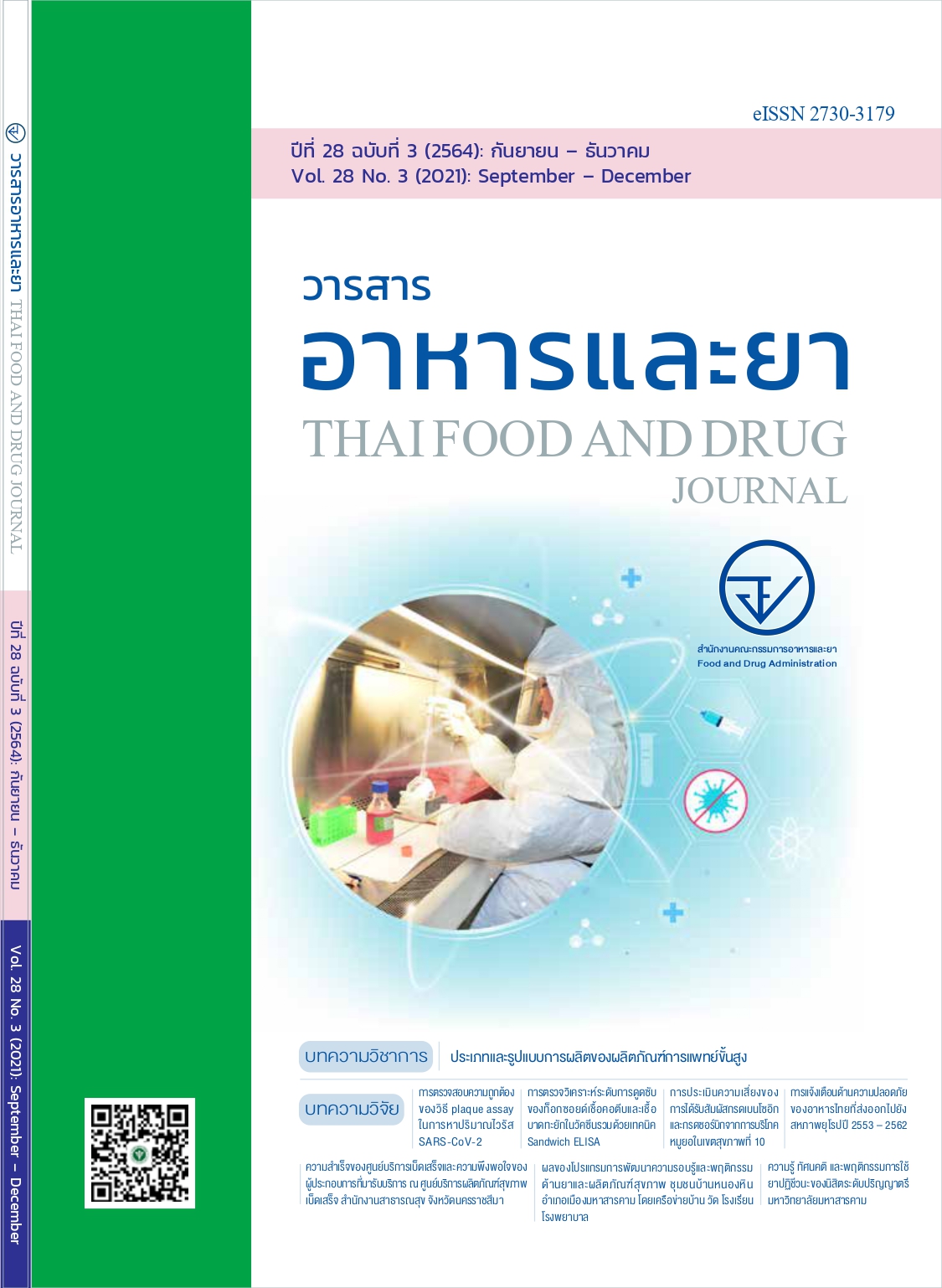ผลของโปรแกรมการพัฒนาความรอบรู้และพฤติกรรมด้านยาและผลิตภัณฑ์สุขภาพ ชุมชนบ้านหนองหิน อำเภอเมืองมหาสารคาม โดยเครือข่ายบ้าน วัด โรงเรียน โรงพยาบาล
Main Article Content
บทคัดย่อ
ความสำคัญ: ประชาชนยังขาดความตระหนักรู้ด้านสุขภาพ ดังนั้นการพัฒนาศักยภาพให้แก่ประชาชนมีความรอบรู้และมีพฤติกรรมการบริโภคยาและผลิตภัณฑ์สุขภาพที่ถูกต้องจึงเป็นสิ่งที่สำคัญ
วัตถุประสงค์: เพื่อศึกษาผลของโปรแกรมการพัฒนาความรอบรู้และพฤติกรรมด้านยาและผลิตภัณฑ์สุขภาพ ชุมชนบ้านหนองหิน อำเภอเมืองมหาสารคาม โดยเครือข่ายบ้าน วัด โรงเรียน โรงพยาบาล (บวร.ร.)
วิธีการวิจัย: เป็นการศึกษาแบบมีส่วนร่วม ใช้กลุ่มตัวอย่าง 180 คน ในชุมชนหมู่บ้านหนองหิน ต.โคกก่อ อ.เมือง จ.มหาสารคาม เครื่องมือที่ใช้คือแบบสอบถามเพื่อวัดความรอบรู้และประเมินพฤติกรรม วิเคราะห์โดยใช้สถิติเชิงพรรณนา Paired-t-test, McNemar’s chi-squraed test, pearson product-moment correlation และ stepwise multiple regression ดำเนินการช่วงตุลาคม พ.ศ. 2562–ธันวาคม พ.ศ. 2563
ผลการศึกษา: ผลการศึกษาพบว่าการใช้โปรแกรมการพัฒนาศักยภาพเครือข่าย บวร.ร. ทำให้ผลของคะแนนความรอบรู้และพฤติกรรมด้านยาและผลิตภัณฑ์สุขภาพของเครือข่าย บวร.ร. สูงขึ้นอย่างมีนัยสำคัญทางสถิติ ความรอบรู้ด้านยาและผลิตภัณฑ์สุขภาพของเครือข่าย บวร.ร. อยู่ในระดับ “มาก” โดยกลุ่มตัวอย่างมีระดับคะแนนความรอบรู้ด้านยาคือ 3.93 สูงกว่าด้านผลิตภัณฑ์สุขภาพ (p<0.05) หลังการใช้โปรแกรมพัฒนาฯ พบว่าคะแนนด้านพฤติกรรมหมวดอาหารคือ 4.03 อยู่ในระดับ “มาก” และแตกต่างจากก่อนพัฒนาอย่างมีนัยสำคัญทางสถิติ (p<0.05) พบความสัมพันธ์ระหว่างคะแนนความรอบรู้กับคะแนนด้านพฤติกรรมหลังการให้โปรแกรมการพัฒนาด้านอาหารและเครื่องสำอางกับกลุ่มตัวอย่างมีความสัมพันธ์กันอย่างมีนัยสำคัญทางสถิติ โดยมีระดับความสัมพันธ์เชิงบวกแบบ small correlation (r=0.30, 0.15, p<0.05) ปัจจัยด้านเพศ อายุ การศึกษาและอาชีพส่งผลต่อความรอบรู้ด้านยา และพฤติกรรมการบริโภคอาหารก่อนให้โปรแกรมฯ อย่างมีนัยสำคัญทางสถิติที่ r2=0.11, F(4,175)=5.57, p<0.05 และ r=0.06, F(4,175)=2.67, p<0.05 ตามลำดับ
สรุป: การเสริมสร้างความรอบรู้ด้านยาและผลิตภัณฑ์สุขภาพให้กับประชาชนมีความสำคัญ เพราะมีแนวโน้มว่าผู้ที่มีความรอบรู้ที่สูงกว่าจะสามารถคุ้มครองตนเองได้มากกว่า โดยต้องพัฒนาไปพร้อม ๆ กันในทุกภาคส่วนของโครงสร้างเชิงสังคม ได้แก่ บ้าน วัด โรงเรียน โดยมีโรงพยาบาลเป็นตัวเชื่อมประสานความยั่งยืน
Article Details

อนุญาตภายใต้เงื่อนไข Creative Commons Attribution-NonCommercial-NoDerivatives 4.0 International License.
เอกสารอ้างอิง
อาทิตย์ พันเดช. สานพลังผู้บริโภคทั่วไทย ร่วมใจแจ้งเบาะแสผลิตภัณฑ์สุขภาพผิดกฎหมายร้องเรียน ร้องทุก กับ อย.: อย. กับภารกิจการคุ้มครองผู้บริโภคด้านผลิตภัณฑ์สุขภาพ. วารสารอาหารและยา 2557;21(1):76-8.
สำนักงานคณะกรรมการอาหารและยา. รายงานข้อมูลฉบับสมบูรณ์ ครั้งที่ 2 โครงการ จัดทำโพลมาตรฐานเกี่ยวกับผลิตภัณฑ์สุขภาพ. นนทบุรี: สำนักงาน. 2562.
คณะกรรมาธิการขับเคลื่อนการปฏิรูปประเทศด้านสาธารณสุขและสิ่งแวดล้อม. การปฏิรูปความรอบรู้และการสื่อสารสุขภาพ. กรุงเทพ: สำนักงานเลขาธิการสภาผู้แทนราษฎร; 2559.
รัชตะ รัชตะนาวิน, อัมรินทร์ ทักขิญเสถียร, ละออ ชัยลือกิจ, อรัญญา สว่างอริยะสกุล, ชะอรสินธุ์ สุขศรีวงศ์, เพชรัตน์ พงษ์เจริญสุข และคณะ. โครงการศึกษาความชุกของปัญหาทางคลินิกที่เกิดจากการใช้สารที่มีสเตียรอยด์ปะปนโดยไม่มีข้อบ่งชี้ทางการแพทย์:รายงานวิจัยฉบับสมบูรณ์. กรุงเทพฯ: สำนักงานคณะกรรมการส่งเสริมวิทยาศาสตร์ วิจัยและนวัตกรรม. 2550.
กองบริหารการสาธารณสุข กระทรวงสาธารณสุข. แนวทางการดำเนินงานพัฒนาระบบการใช้ยาอย่างสมเหตุผลในชุมชน. นนทบุรี: กอง. 2563.
กองพัฒนาศักยภาพผู้บริโภค สำนักงานคณะกรรมการอาหารและยา. อย. เผยสถิติการเฝ้าระวังโฆษณาผลิตภัณฑ์สุขภาพปีงบ 2558 ยอดปรับกว่า 1.9 ล้านบาทพร้อมตรวจเข้มปีงบ 2559 [อินเทอร์เน็ต]. นนทบุรี: กอง; 2559 [เข้าถึงเมื่อ 29 ม.ค. 2564.] เข้าถึงได้จาก: http://pca.fda.moph.go.th/public_media_detail.php?id=2&cat=50&content_id=694
Nutbeem D. The evolving concept of heath literacy. Soc Sci Med. 2008;67:2072-78. doi: 10.1016/j.socscimed.2008.09.050. Epub 2008 Oct 25. PMID: 18952344.
สำนักงานคณะกรรมการอาหารและยา. คู่มือการเก็บรวบรวมข้อมูลการใช้ยาปลอดภัยในชุมชน. นนทบุรี: สำนักงาน; 2560.
กองพัฒนาศักยภาพผู้บริโภค สำนักงานคณะกรรมการอาหารและยา. แบบสอบถามการวัดความรู้และพฤติกรรมเกี่ยวกับผลิตภัณฑ์สุขภาพภายใต้โครงการชุมชนเครือข่ายรวมใจป้องกันภัยผลิตภัณฑ์สุขภาพ (บวร.ร.). นนทบุรี: กอง; 2563.
วรางคณา สันเทพ. ถอดบทเรียนการดำเนินงานคุ้มครองผู้บริโภคฯโดยเครือข่าย “บวร.ร.” (บ้าน วัด โรงเรียน โรงพยาบาล) จังหวัดลำปาง. วารสารวิชาการสุขภาพภาคเหนือ. 2562;6(1)11-30.
สิริลักษณ์ รื่นรวย. การจัดการปัญหายาและผลิตภัณฑ์สุขภาพในชุมชนโดยเครือข่าย บวร.ร. วารสารเภสัชกรรมไทย 2563;6(1):11-30.
จิรชัย มงคลชัยภักดิ์, จิรวัฒน์ รวมสุข, เอมอร ชัยประทีป. การศึกษาความรู้และพฤติกรรมเกี่ยวกับการใช้ยาปฏิชีวนะของผู้รับบริการในร้านยาชุมชนจังหวัดปทุมธานี. วารสารวิชาการมหาวิทยาลัยอีสเทิร์นเอเชีย 2555;6(2):91-100.
คุณากร ปาปะขา, วงศา เล้าหศิริวงศ์. สถานการณ์และปัจจัยที่มีความสัมพันธ์กับการใช้ยาปฏิชีวนะของกลุ่มวัยแรงงานในจังหวัดมหาสารคาม. วารสารวิทยาลัยพยาบาลบรมราชชนนี. 2561;34(2):13-22.
นิธิมา สุ่มประดิษฐ์, เสาวลักษณ์ ฮุนนางกูร, ภูษิต ประคองสาย, วิษณุ ธรรมลิขิตกุล, การกระจายและการใช้ยาปฏิชีวนะของโรงพยาบาลส่งเสริมสุขภาพตำบล คลินิก และร้านยา. วารสารวิจัยระบบสาธารณสุข 2556;7(2):268-80.
Sutapakdi U, Arparsrithongsagul S, Satawongtip W. Epidemiology. Ya-Chud use behavior of people in Mahasarakham. Mahasarakham: Mahasarakham University; 2000.
สำนักงานคณะกรรมการอาหารและยา. โครงการสำรวจพฤติกรรมและความเชื่อมั่นของผู้บริโภคที่มีต่อผลิตภัณฑ์สุขภาพ ประจำปีงบประมาณ พ.ศ. 2563. นนทบุรี: สำนักงาน; 2563.


